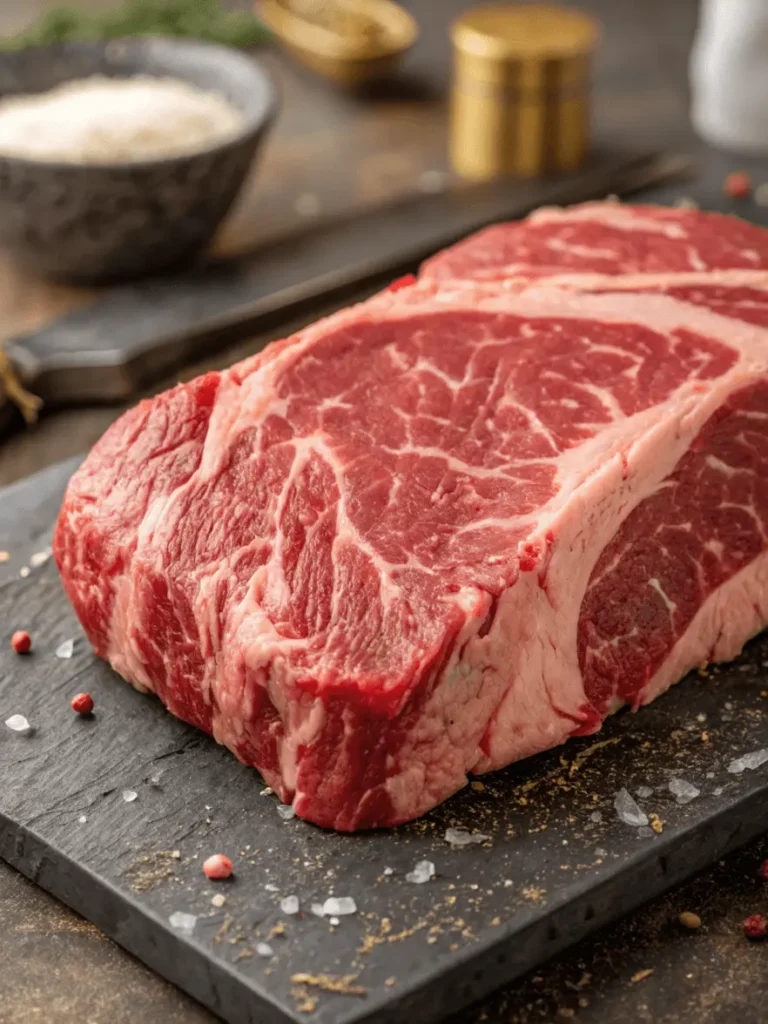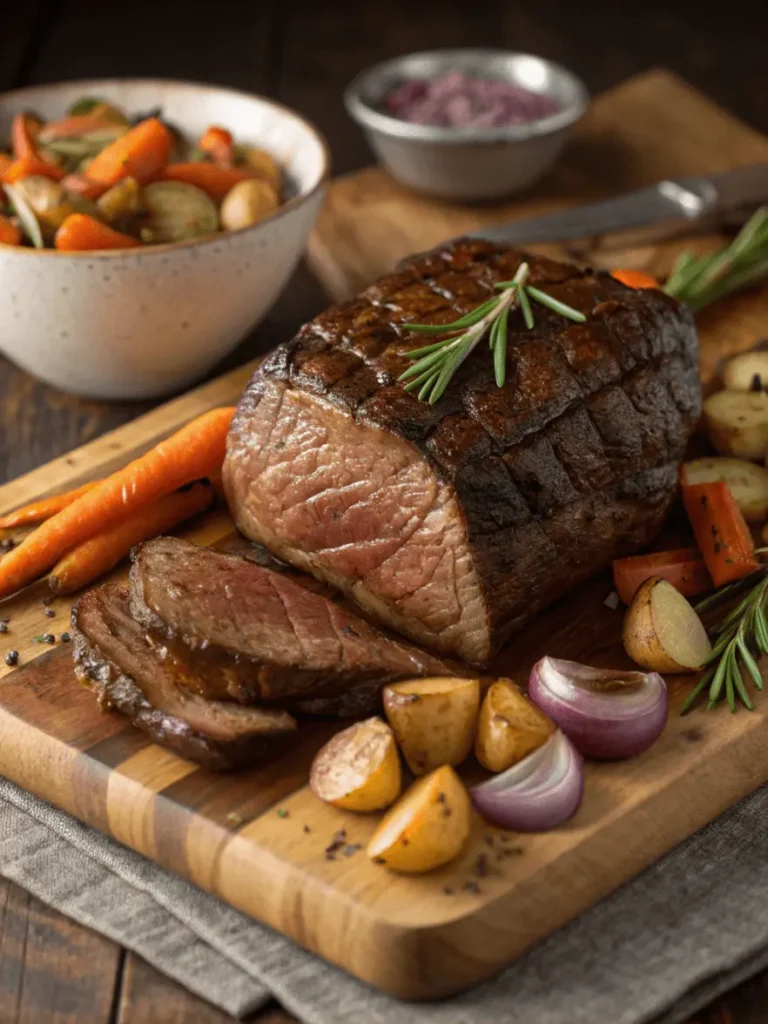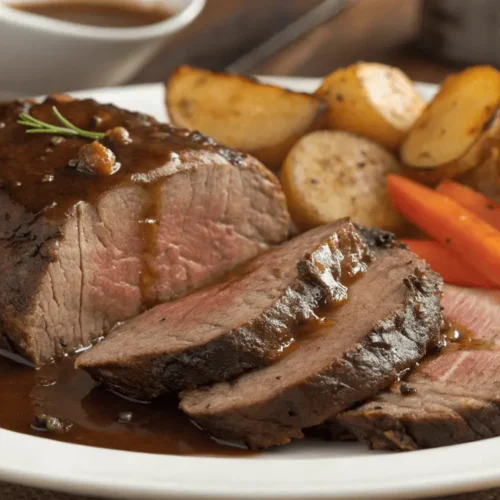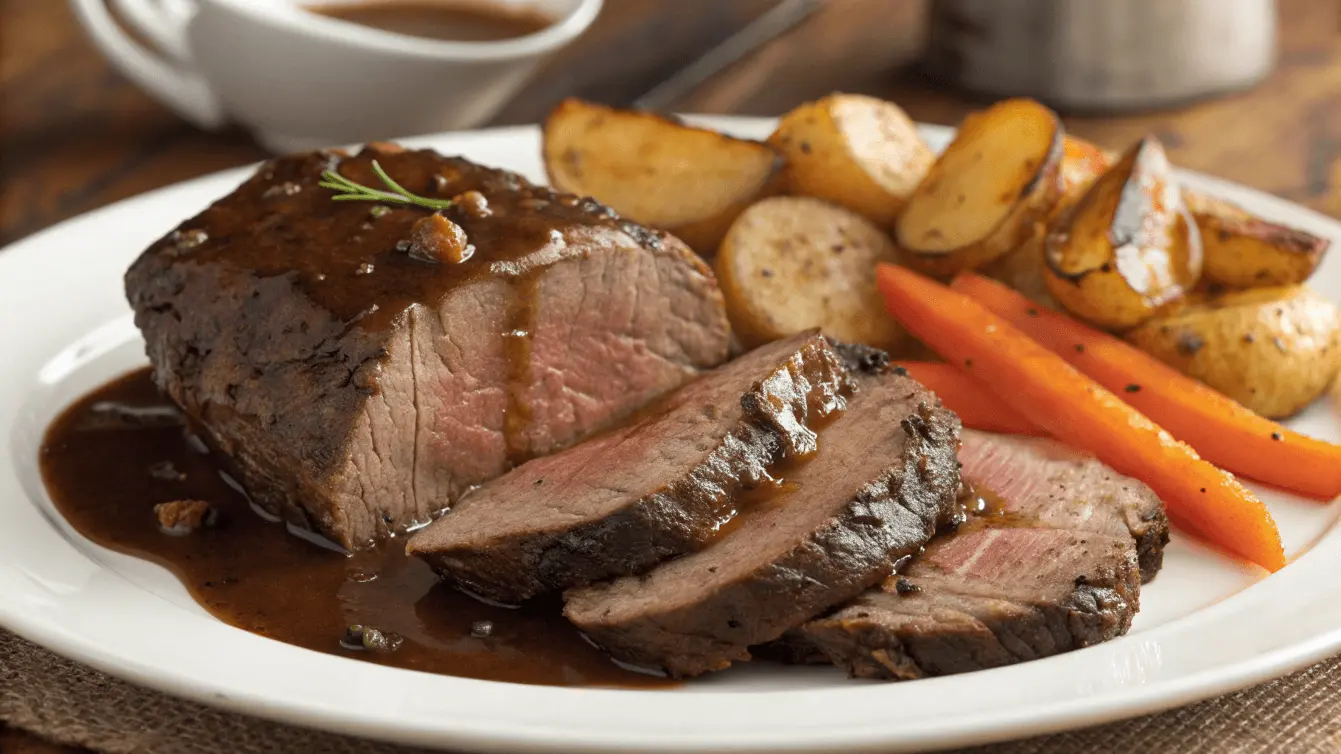Nothing beats the smell of a slow-cooked, tender chuck roast filling your home with rich, savory aromas. But let’s be honest—cooking a large cut of beef can feel intimidating. Maybe you’ve tried before, only to end up with something too tough or too dry. Don’t worry! This chuck roast recipe is here to change the game. It’s simple, practically foolproof, and delivers melt-in-your-mouth results every time. Whether you’re a beginner or a seasoned cook, you’ll love how effortlessly this dish comes together.
Imagine slicing into a perfectly juicy, flavor-packed chuck roast, served with your favorite sides. It’s hearty, comforting, and surprisingly versatile—great for meal prep or feeding a crowd. Plus, the slow cooking process locks in all the goodness, making every bite incredibly satisfying. Ready to master this recipe? Stick with me, and I’ll walk you through every step to ensure your roast turns out absolutely perfect!
Table of Contents
Choosing the Best Chuck Roast for Maximum Flavor
Selecting the Right Cut for Tender Results

When it comes to making the best chuck roast recipe, the cut of meat you choose matters—a lot! You want a cut that’s rich in flavor and cooks down into something incredibly tender. The best chuck roast comes from the shoulder area of the cow, where there’s plenty of connective tissue. When slow-cooked, these tissues break down, making the meat fork-tender and juicy.
First, always go for bone-in chuck roast if you can. The bone adds extra flavor and keeps the meat moist during cooking. If bone-in isn’t available, don’t worry! Boneless works just as well when prepared properly. Next, pay attention to the color. A fresh cut of chuck roast should have a deep red hue. If it looks brown or has grayish spots, skip it.
Also, take a second to feel the meat. It should be firm but not overly stiff. If it’s too soft, it might not have enough structure for slow cooking. The fat content is just as important. You want a good balance—too much fat, and your roast will be greasy; too little, and it might turn dry.
Another great tip? Ask your butcher for recommendations. They know their cuts and can help you pick the perfect piece. If you’re shopping at a grocery store, look for labels like “chuck roll roast” or “shoulder roast.” These are signs you’re on the right track.
Quick Guide to Picking the Best Chuck Roast:
- Bone-in vs. Boneless – Bone-in has extra flavor, but boneless is easier to slice.
- Color – Deep red with no gray or brown patches.
- Firmness – Should be slightly firm, not too soft.
- Fat Content – A good mix of lean meat and marbling for tenderness.
- Labeling – Look for “chuck roll roast” or “shoulder roast.”
If you’re curious about alternative beef cuts, you might find this beef cheek meat recipe interesting—it’s another underrated cut that becomes incredibly tender with slow cooking.
Marbling and Thickness: What to Look For
Now, let’s talk about the secret to a flavorful chuck roast—marbling! Marbling refers to the little white streaks of fat running through the meat. This fat slowly melts as the roast cooks, creating juicy, fall-apart bites. The more marbling, the better! However, you don’t want a roast that’s all fat—you need the perfect balance.
Also, consider the thickness of the roast. A chuck roast should be at least 2 inches thick for the best results. If it’s too thin, it can dry out. A thicker roast holds moisture better and creates that rich, beefy flavor everyone loves.
When checking marbling, look for even distribution. Some chuck roasts will have large fat chunks on the edges but not much inside. These cuts won’t be as tender because the fat isn’t evenly spread throughout the meat. Instead, choose a roast with fine, web-like fat streaks across the surface.
Marbling & Thickness Guide:
| Factor | Ideal Choice | Why It Matters |
|---|---|---|
| Marbling | Even fat distribution throughout | Enhances juiciness and tenderness |
| Fat Chunks | Small and spread out | Prevents greasy texture |
| Thickness | At least 2 inches | Helps retain moisture |
| Fat Color | Creamy white, not yellow | Indicates freshness |
A good rule of thumb? More marbling = more flavor. But don’t go overboard—too much fat can make the roast greasy instead of melt-in-your-mouth delicious.
So next time you’re at the store, take a moment to check the cut, color, and marbling. These small details make a huge difference in the final dish. Once you have the perfect chuck roast, you’re ready to cook up something truly incredible!
Looking for other beefy cuts that pack flavor? Find out if beef heart is better than steak in terms of texture and taste!
Essential Cooking Techniques for a Perfect Chuck Roast
Low and Slow vs. High Heat: Which Method Works Best
When it comes to making the perfect chuck roast recipe, the cooking method makes all the difference. You might be tempted to crank up the heat and cook it fast, but that’s a one-way ticket to tough, chewy meat. Instead, the secret to a mouthwatering chuck roast is low and slow cooking.
Low heat allows the connective tissues in the meat to break down over time, transforming it into a fork-tender masterpiece. This process happens around 190-210°F (88-99°C), which is the sweet spot for collagen to turn into gelatin. The longer the roast cooks at this temperature, the more flavorful and juicy it becomes.
On the other hand, high heat can be useful at the very end of cooking to add a rich, crispy crust. If you’re roasting in the oven, consider searing the meat first at 450°F (232°C) for 15 minutes, then lowering the heat for slow cooking. If using a slow cooker, sear it in a pan first for extra depth of flavor.
Let’s compare both methods:
| Cooking Method | Temperature | Best Use | Time Required |
|---|---|---|---|
| Low & Slow | 275-325°F (135-163°C) | Tender, juicy meat | 4-8 hours |
| High Heat | 400-450°F (204-232°C) | Creates a flavorful crust | 15-20 minutes (before or after slow cooking) |
So, what’s the best approach? Use both! Start by searing on high heat, then let the roast cook low and slow for the best results.;
If you love hearty, flavorful beef dishes, you might also enjoy this ribeye roast recipe, which shares some of the same slow-cooking secrets!
Best Cooking Tools for a Foolproof Chuck Roast
The right tools make cooking a chuck roast recipe much easier. Whether you’re using an oven, slow cooker, or Instant Pot, having the right gear ensures consistent results.
First, you need a heavy-duty roasting pan or Dutch oven. These retain heat well and help distribute it evenly, preventing hot spots. If you’re using a slow cooker, choose one with a low-and-slow setting to maintain a steady temperature.
A meat thermometer is a must-have. The roast is ready when it reaches 195-205°F (90-96°C). This guarantees that the connective tissues have fully broken down, leaving you with a tender, flavorful roast.
If you love convenience, an Instant Pot is a game-changer. It reduces cooking time significantly while still producing fall-apart meat. But remember, pressure cooking won’t give you a crust, so searing before or after is essential.
Must-Have Tools for Cooking Chuck Roast
- Dutch oven or roasting pan – Perfect for oven roasting, retains heat well.
- Slow cooker – Ideal for set-it-and-forget-it cooking, keeps the roast moist.
- Instant Pot – Speeds up the cooking process while preserving tenderness.
- Meat thermometer – Ensures the roast is perfectly cooked, not under or overdone.
- Tongs and spatula – Helps with flipping and handling meat safely.
- Sharp knife – Essential for slicing the roast into tender portions.
Want a quick visual guide? Here’s a chart comparing cooking tools:
| Tool | Best For | Additional Benefits |
|---|---|---|
| Dutch Oven | Oven roasting | Deep, rich flavors, even cooking |
| Slow Cooker | Hands-off cooking | Keeps moisture locked in |
| Instant Pot | Faster cooking | Cuts time in half while keeping meat tender |
| Meat Thermometer | Precision cooking | Prevents overcooking or undercooking |
By using the right tools and techniques, you’ll turn an ordinary chuck roast into something unforgettable. Now that you’re equipped with the best methods, let’s move on to seasoning and flavors!
Flavor Enhancements and Pairing Suggestions

Classic Seasonings and Marinades for Rich Taste
The right seasonings can take your chuck roast recipe from good to unforgettable. Chuck roast naturally has a deep, beefy flavor, but with the right blend of spices and marinades, you can bring out even more richness.
First, let’s talk about dry rubs. A dry rub adds a delicious crust while enhancing the meat’s natural flavors. A classic blend includes salt, black pepper, garlic powder, onion powder, smoked paprika, and a touch of cayenne for heat. The key is to massage it into the meat and let it sit for at least an hour—overnight is even better!
For an even deeper flavor, marinating your chuck roast is a game-changer. Marinades help break down the fibers, making the meat extra tender. A good marinade includes olive oil, Worcestershire sauce, soy sauce, minced garlic, and fresh herbs like rosemary and thyme. These ingredients soak into the meat, making every bite juicy and flavorful.
Want to boost the taste even more? Try adding umami-rich ingredients like balsamic vinegar or Dijon mustard to your seasoning mix. They help intensify the flavor and create a mouthwatering finish.
Best Seasonings for Chuck Roast:
| Ingredient | Why It Works | Flavor Boost |
|---|---|---|
| Salt | Enhances natural meat flavor | Essential for tenderness |
| Black Pepper | Adds warmth and spice | Balances richness |
| Garlic Powder | Infuses deep savory notes | Great for slow cooking |
| Onion Powder | Brings a hint of sweetness | Complements garlic |
| Smoked Paprika | Adds a smoky, earthy taste | Works well for roasting |
| Worcestershire Sauce | Boosts umami flavors | Helps with tenderness |
Side Dishes That Complement Chuck Roast Perfectly
A rich, slow-cooked chuck roast recipe deserves the perfect side dishes to round out the meal. Since chuck roast is hearty and filling, the best pairings balance the flavors and textures.
For something classic and comforting, you can’t go wrong with mashed potatoes. They soak up all the savory juices, making every bite even better. Roasted root vegetables like carrots, parsnips, and sweet potatoes add a natural sweetness that balances the deep, beefy flavors.
If you prefer a lighter side, a crisp, refreshing salad is a great contrast to the roast’s richness. A simple arugula salad with a lemon vinaigrette cuts through the heaviness while adding a fresh burst of flavor.
Want something extra special? Try making buttery dinner rolls or garlic bread to soak up all that delicious sauce. And for an easy, no-fuss option, steamed green beans or sautéed Brussels sprouts work beautifully.
Best Side Dish Pairings:
- Mashed Potatoes – Creamy, rich, and the perfect match for gravy.
- Roasted Vegetables – Carrots, parsnips, and potatoes bring a natural sweetness.
- Steamed Green Beans – A simple, fresh side that balances the meal.
- Garlic Bread or Dinner Rolls – Great for scooping up the flavorful juices.
- Fresh Salad – A light, crisp contrast to the roast’s richness.
| Side Dish | Flavor Balance | Why It Works |
|---|---|---|
| Mashed Potatoes | Creamy & rich | Absorbs the flavorful juices |
| Roasted Carrots & Parsnips | Sweet & earthy | Balances the deep beefy taste |
| Green Beans | Light & crisp | Refreshes the palate |
| Garlic Bread | Buttery & crispy | Perfect for soaking up sauces |
Pair your chuck roast with one or more of these sides, and you’ll have a perfectly balanced meal that’s both satisfying and delicious! Now that we’ve got the flavors covered, let’s move on to cooking methods!
Now that you’ve got the perfect cut, the best seasonings, and the ultimate side pairings, it’s time for the fun part—cooking! Get ready to turn that flavorful chuck roast into a tender, juicy masterpiece that melts in your mouth. Let’s dive into the recipe and make it happen!

chuck roast recipe
Ingredients
- 3 ½ to 4 pounds Beef chuck roast
- 2 tbsp Olive oil
- 1 Yellow onion peeled and julienned
- 2 Leeks thinly sliced and rinsed, white and yellow parts only
- 6 Garlic cloves thinly sliced
- 1 cup Red grape juice + vinegar
- 3 tbsp Tomato paste
- 6 cups Beef stock
- 2 Bay leaves
- 8 sprigs Fresh thyme
- 8 sprigs Fresh parsley stems with leaves
- 2 pounds Baby Yukon potatoes
- 6 Carrots peeled and cut into 2” pieces
- 4 Celery ribs cut into 2” pieces
- 2 Parsnips peeled and cut into 2” pieces
- 1 Rutabaga peeled and cut into 1” cubes
Instructions
- Sear the Chuck Roast for Maximum FlavorFirst, pat the chuck roast dry with a paper towel. This helps it sear properly. Heat the olive oil in a large Dutch oven or heavy-bottomed pot over medium-high heat. Once hot, place the roast in the pot and sear each side for about 4-5 minutes until a deep golden-brown crust forms. Then, remove the roast and set it aside.
- Sauté the AromaticsLower the heat to medium and add the onions, leeks, and garlic to the same pot. Stir and cook for 3-4 minutes until softened and fragrant. Then, add the tomato paste and stir well, letting it cook for 1 minute to enhance its richness.
- Deglaze and Build the BrothPour in the red grape juice and vinegar mixture, scraping the bottom of the pot to lift all those flavorful browned bits. Let it simmer for 2 minutes before adding the beef stock, bay leaves, thyme, and parsley. Bring to a simmer.
- Slow Cook to PerfectionReturn the seared chuck roast to the pot, ensuring it’s partially submerged in the broth. Cover with a lid and let it cook on low heat for 3 to 3 ½ hours, or until the meat is fork-tender.
- Add the Vegetables for the Final TouchWith 45 minutes left, add the potatoes, carrots, celery, parsnips, and rutabaga to the pot. Stir gently and continue cooking until the vegetables are tender. Remove bay leaves and herb stems before serving.
Notes
- For extra depth of flavor, let the chuck roast marinate with salt, pepper, and garlic for an hour before cooking.
- Want a thicker broth? Remove a cup of cooked vegetables, mash them, and stir them back into the broth.
- Short on time? Use a pressure cooker to reduce cooking time to about 90 minutes.
- Storage tip: This dish tastes even better the next day! Store leftovers in an airtight container in the fridge for up to 4 days.
Frequently Asked Questions (FAQs)
Which cooking method is best for a chuck roast?
The best way to cook a chuck roast recipe is low and slow. Slow cooking at a low temperature breaks down tough fibers, making the meat incredibly tender. You can braise it in the oven, use a slow cooker, or even try a pressure cooker. Each method works, but the key is patience. The longer it cooks, the better it gets!
Is chuck roast better in the oven or crockpot?
Both methods work great, but it depends on what you want! If you love a deep, caramelized crust, the oven is best. It lets the flavors build while roasting. If you prefer a hands-off approach, the crockpot is perfect. It keeps the meat juicy while slowly tenderizing it. Either way, this chuck roast recipe turns out rich, flavorful, and absolutely delicious.
Does chuck roast get more tender the longer you cook it?
Yes! Chuck roast needs time to become tender. The slow cooking process allows the connective tissues to break down, turning tough meat into melt-in-your-mouth goodness. But don’t overdo it! If cooked too long, the meat can dry out. The sweet spot for a chuck roast recipe is around 3 to 4 hours in the oven or 6 to 8 hours in a slow cooker.
How is chuck best cooked?
Chuck roast is best cooked slowly with moisture. Braising—cooking it in broth at a low temperature—is the secret to its juicy tenderness. A Dutch oven, slow cooker, or Instant Pot works wonders. First, sear the meat for extra flavor, then let it simmer until tender. Follow this method, and your chuck roast recipe will turn out rich, hearty, and incredibly satisfying!
Conclusion: Enjoy a Hearty, Flavor-Packed Chuck Roast
You did it! Now you know exactly how to make a chuck roast recipe that’s rich, tender, and packed with flavor. First, you picked the perfect cut. Then, you seasoned it just right. Next, you cooked it low and slow, letting all the flavors come together beautifully. Finally, you paired it with delicious sides to create the ultimate meal.
This dish is all about comfort and simplicity. Whether you’re making it for a cozy family dinner or meal-prepping for the week, it never disappoints. Plus, leftovers taste even better the next day!
Now it’s your turn. Grab your ingredients, follow the steps, and enjoy every bite. Cooking should be fun, and this recipe makes it easy. So, what are you waiting for? Try this chuck roast recipe today, and treat yourself to a meal that’s as satisfying as it is delicious!


1 thought on “Melt-in-Your-Mouth Chuck Roast Recipe – The Best Way to Cook It Perfectly!”